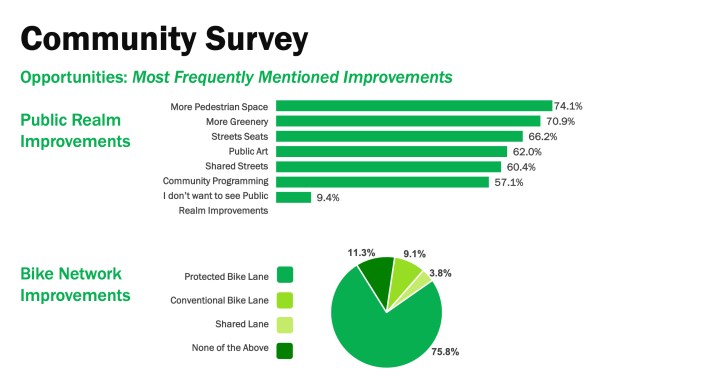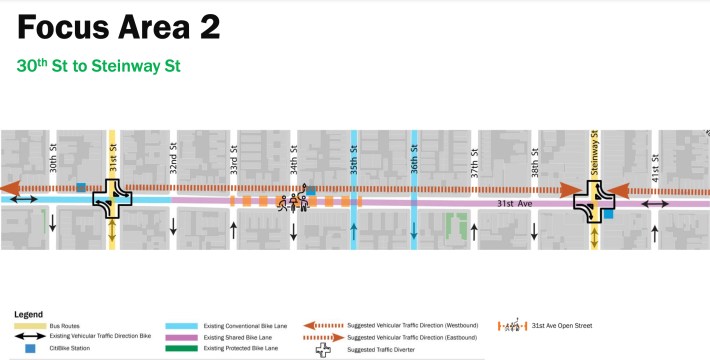Astorians want the city to install protected bike lanes on 31st Avenue to finally give the neighborhood a safe east-west route, locals told officials at a crowded community meeting last week.
That support mirrors a survey that the Department of Transportation presented at a workshop last week: More than three-in-four, or 76 percent, came out in support of protected bike lanes for 31st Ave. between Vernon Boulevard and 51st Street, currently being designed with the "bike boulevard" configuration.
A similar rate, 74 percent, wanted more pedestrian space, according to the survey, where more than nine in 10 respondents said they lived in the area.
Only 11 percent didn't want any bike lane, and only 9 percent said they didn't want public realm improvements.

DOT has increasingly rolled out bike boulevards, which are redesigns to slow down drivers and divert through traffic, a proven configuration that makes streets safer for people on bikes and pedestrians, yet still allows drivers to access all buildings and store their vehicles in curbside spaces.
A nearby example is 39th Avenue in Sunnyside, which has features plastic traffic diverters, protected bike lanes, and shared lanes with car traffic. Boulevard are in the works on the former Berry Street open street in Williamsburg and on Underhill Avenue in Prospect Heights.
Locals said that any design must include a protected path for cyclists as a baseline, given that the Queens neighborhood has no east-west bike routes physically separated from cars except for 20th Avenue at its northern edge, and because drivers have killed several cyclists on area streets.
“As big as Astoria is, as many people live here, it is an embarrassment that we don’t have a single east-west protected bike lane,” said Huge Ma, a local safe streets advocate who rose to fame earlier in the pandemic by starting the online vaccine portal TurboVax.
DOT reps did not reveal many specifics for 1.7-mile corridor, except for some preliminary suggestions to turn the road from a two-way street into one way, and flipping directions several times at intersections with traffic diverters. Two-way to one-way conversions tend to be controversial.

The north-south protected bike lanes on a similarly-long stretch of Crescent Street that DOT installed under the de Blasio administration two years ago were a game-changer, according to Ma.
“I see a lot of parents taking their kids to school, either riding together or on push scooters, or on cargo bikes — and that’s something I never would have seen before the bike lane,” he said. "More of our neighbors deserve the same benefits."
The northern Queens section is a Vision Zero Priority Area due to its particularly high rate of traffic violence, with DOT counting 264 injuries and one cyclist killed there between 2016-2020. It’s even worse than those numbers suggest, as a look at city crash data shows that there have been a whopping 853 crashes during that time injuring 270 people — about one injury a week.

The road violence has had a deadly toll on the neighborhood.
On Jan. 5, a cement truck driver fatally struck Tamara Chuchi Kao, 62, at 24th Avenue and 29th Street, neither of which has a protected bike lane. A month after that, a driver killed 7-year-old Dolma Naadhum as she crossed the street, and in April, 16-year-old cyclist Jayden McLaurin was killed in a hit-and-run.
More than 150 people packed into a meeting with DOT on Sept. 14 to push for life-saving measures on 31st Avenue.
Astorians showed up last night for pedestrian + bike safety: over 150 neighbors packed the room at Variety Boys & Girls Club to talk about how we make our streets safer.
— Zohran Kwame Mamdani (@ZohranKMamdani) September 15, 2023
Thank you, @NYC_DOT for hosting this important event. pic.twitter.com/QIgWTbngv6
The workshop was organized with the area’s politicians, who support a protected bike lane in the area, they wrote in a Streetsblog op-ed last week.
“It was incredible, the room was packed with people who support safer streets in Astoria,” said Laura Shepard, a Queens organizer with Transportation Alternatives. “A lot of people really want to see protected bike lanes, traffic reductions.”
Officials broke down the 31st Avenue project area into three sections and collected feedback from the attendees for each stretch:
- Vernon Boulevard-30th Street, which is mostly residential and connects to the waterfront.
- 30th to Steinway Street, which is more commercial, but also has a two-block open street on weekends between 33rd-35th streets.
- Steinway to 51st Street, where there’s more residential buildings, schools, and “auto-oriented businesses,” according to DOT.
Agency spokesman Scott Gastel said the DOT will keep taking feedback, adding that one-way conversions offer "broad possibilities for bike and public realm improvements."
DOT plans to give a more “refined” design to Community Board 1 — but not until next spring or summer.






